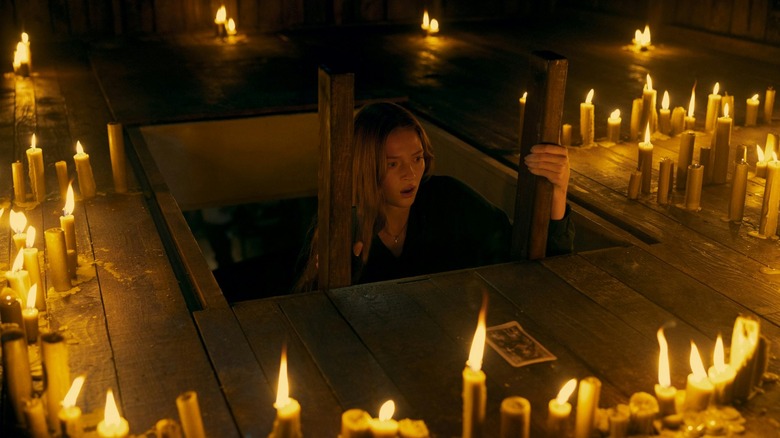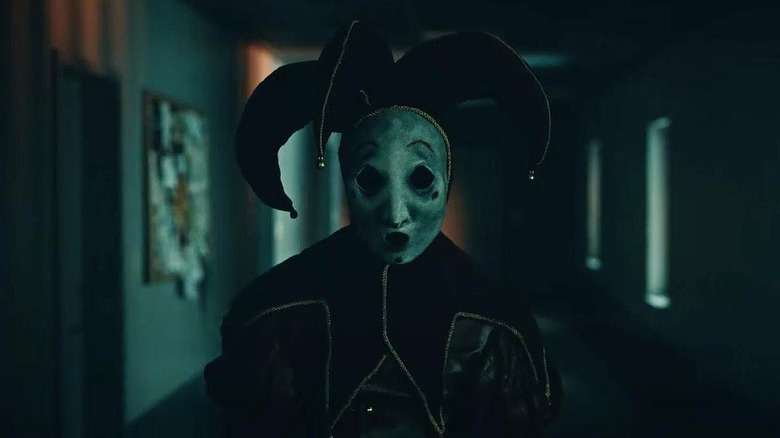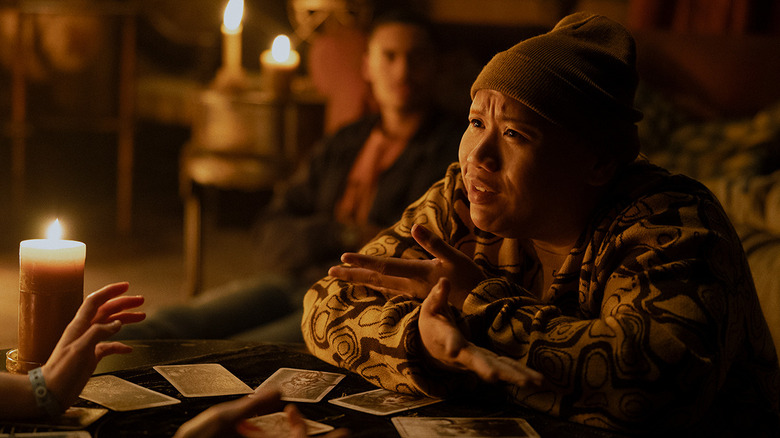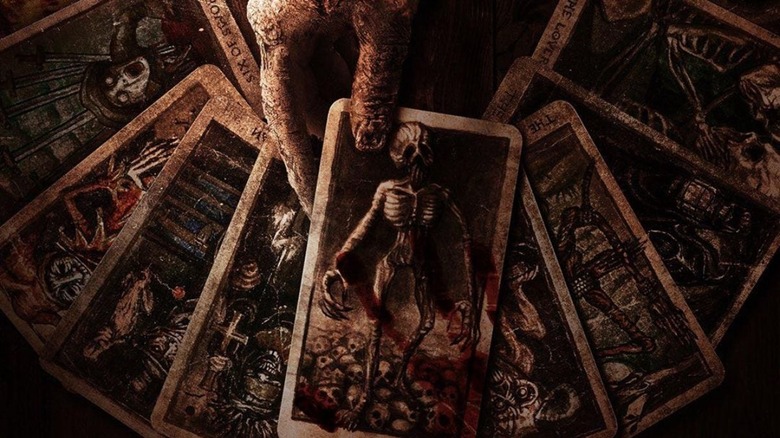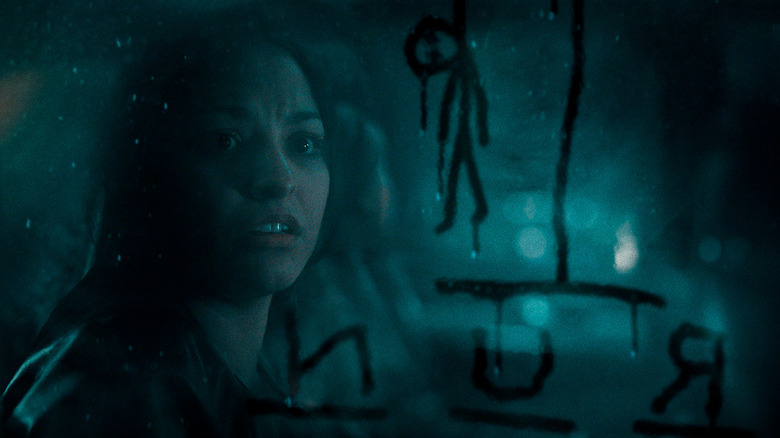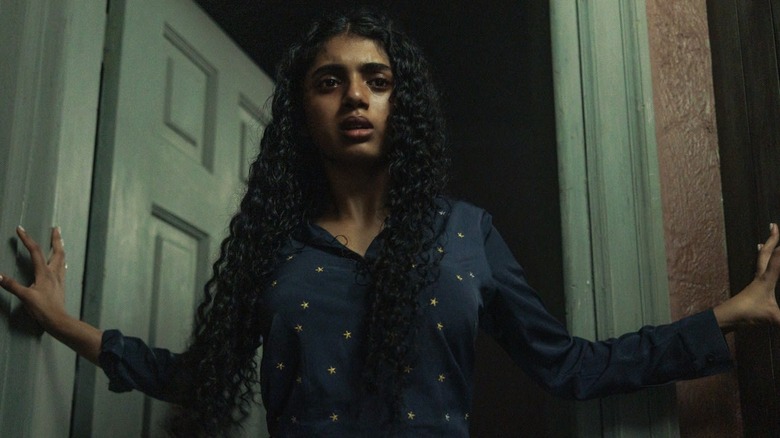Tarot Is 2024's Sneaky Horror Box Office Hit - Here's How Sony Made It Happen
It has not been a particularly great year for horror movies theatrically. 2024 has been, to put it mildly, pretty rough at the box office overall, with the summer season suffering one disappointment after another. Smaller movies like "In a Violent Nature" are finding success right now, but Hollywood has yet to have a true horror movie breakout hit this year. However, amidst the rubble there is a pretty impressive success story in the form of "Tarot."
Released by Sony on May 3 right alongside Universal's splashy blockbuster "The Fall Guy" to kick off the summer season, "Tarot" opened to an unassuming $6.5 million, placing number four on the charts that weekend. That's not exactly a blockbuster debut, to put it lightly. But the studio was thrifty with this one, making it for just $8.5 million. More importantly, they were also very thrifty and targeted with the marketing spend, which has allowed the film to become something of a sleeper hit. It has since amassed $42 million worldwide — more than Universal's "Abigail" ($41.5 million) and Blumhouse's "Imaginary" ($39.1 million). Both of those movies cost more to make and had far more wide-ranging marketing campaigns.
"When you're talking about $30 million [marketing] spends, you're talking about big TV ads," explained Scott Glassgold in a recent interview with /Film to discuss how Sony managed to pull this off. Glassgold was the on-the-ground producer of "Tarot." This movie didn't have a $30 million marketing spend. While Glassgold couldn't reveal a specific figure he did say "it's significantly less than that."
Glassgold's previously worked with Sony's Screen Gems division on the Scream Gems lab, which was designed to nurture first-time filmmakers. There, he made an acclaimed short film called "Blink" with Spenser Cohen and Anna Hallberg, who ended up writing and directing "Tarot." The short, which starred Sophie Thatcher before her star-making turn on "Yellowjackets," went over so well that the studio opted to let Conner and Hallberg direct the film, with Glassgold coming aboard as a producer.
Cheaper marketing lowers the bar for profit
When we talk about box office, we often talk about a couple of key things; a movie's budget and its global ticket sales. It's all relative, and a movie's ability to profit ultimately relies on dollars earned versus dollars spent. The more expensive a movie is to produce, the more it has to make to become profitable. However, when we talk about budgets, the number cited is almost always the production budget, which does not account for marketing. That's hugely important as that marketing spend greatly impacts the bottom line.
When we look at big 2023 hits like "Evil Dead Rise" ($147 million worldwide) or "Five Nights at Freddy's" ($291 million worldwide), we're talking about movies that spent relatively big on marketing. Sony made a choice to be more targeted with "Tarot" by forgoing a $20 million campaign that would have made it much harder for the film to profit. That meant no traditional TV spots, for example, or even billboards. But as Glassgold explained, that probably wouldn't have been money well spent, in this case:
"If we're looking [at] the comparable lead ups, it would've been during the NBA finals, or the NCAA championships. Our audience is just not on network TV watching these shows. So when you spend X off-set, if you're talking about NBA finals or NCAA championships, you're spending millions of dollars on television and your audience isn't there."
Indeed, traditional TV is dying a very slow death right now in the streaming era. Even major sports are moving to streaming, with the NFL recently cutting a deal to broadcast games on Netflix exclusively on Christmas. Would spending millions on TV spots have added equivalent millions to the box office? Sony's thinking was no, it would not. So, they went about it another way and went all-in on an all-digital, highly-targeted campaign. Looking over the numbers, it appears that strategy worked quite well for them.
Knowing the target audience for Tarot
Again, Glassgold couldn't provide a precise figure for the marketing but social media ads and YouTube are far cheaper than traditional methods. So, given the low $8.5 million production budget and a smaller-than-usual campaign for a studio movie, this film has undoubtedly done well for itself in an under-the-radar way — especially once VOD is factored into the equation for "Tarot." As for how Sony went about executing this targeted campaign? It all had to do with knowing the audience.
Sony decided before production that it was going to be a PG-13 movie and not an R. As a result, they knew they were going for a younger audience, one that tends to connect with media online. "We have a demographic that certainly skews younger," Glassgold said. "In many ways this movie plays what we like to call gateway horror. Since we're not showing the gore and kills on screen, in a sense it plays to even a broader audience and a younger audience." The team also had a couple of successful touchstones they looked to while making the film:
"We felt conceptually, some of our north stars on this movie were the 'Ouija' movies and 'Truth or Dare,' which played to really wide audiences and we felt like that lined up conceptually with what this movie was,"
2014's "Ouija" was a huge hit for Universal in its day, taking in $103 million worldwide against a $5 million budget. Similarly, 2018's "Truth or Dare" made a massive $95 million against a tiny $3.5 million budget. While a sequel to that film never materialized, Blumhouse did try to make it happen. In any event, those were successful examples of PG-13 horror finding a huge audience.
A very targeted, all-digital marketing campaign
"The notion of going digital is both hyper-targeted for your audience in that you're hopefully meeting them where they are. And it's not incidental that it's cost-effective," Glassgold explained. The studio leaned heavily on social media marketing as well as rolling ads into ad-supported streamers. Netflix's ad-supported tier has been a big success, and Prime Video now comes with ads unless users pay more to not have them. That is a growing avenue to explore, especially since that's where younger viewers are.
Even though Hollywood has a complicated relationship with TikTok in some ways, it's no secret that the platform has become a massive way to reach people — particularly young, potential moviegoers. As Glassgold explained, the marketing team for "Tarot" used that to their advantage with some real-world stunts:
"'Tarot' had its own TikTok handle and was outputting really clever material on the build-up to the film ... We did a spot that we shot at The Grove ... That was people sort of arriving at the theater not realizing that behind this huge 'Tarot' display were costumed performers and they were costumed in the monsters of our film. They were jumping out of the display, scaring people. You can look at the numbers because it's out there, but I'm pretty sure we had about 20 million viewers in 24 hours."
The video in question currently has 23.5 million views. A stunt like that brings a lot of attention at a far more affordable rate than a 30-second TV spot during a sporting event that plays while someone is going to the bathroom. For Glassgold, there's also an element of authenticity at play:
"As a father of three teenagers, I can say, whenever it feels like you're selling too hard to this generation, they tune out. But again, if you can meet them where they are and do a prank like that, that obviously incorporates all your vitals of visuals from the film, release date that is theatrical, release all those things, into something that in and of itself is original entertainment, it goes really far."
Tarot wasn't a critical darling, but that didn't matter
What can't be ignored is the critical reception. As of this writing, "Tarot" holds a 19% approval rating on Rotten Tomatoes. To put it lightly, that's not great. That said, horror is a surprisingly resilient genre and isn't always as reliant on critics to help boost a film's profile. "I think when we are making the film, we know we're sort of making a populist film," Glasgold said. Might better reviews have helped? Sure. But the bad ones didn't kill "Tarot."
Be that as it may, that Rotten Tomatoes number and early reviews have become a huge part of the larger cultural discussion surrounding any film's release. Glassgold expressed nothing but respect for critics in our conversation but the team understood the film they made probably wasn't going to become the next darling of Film Twitter:
"I love film criticism and I think it's a cornerstone of what we do, and so I say that before I say anything else. When it comes to our reviews, again, if 'Ouija' is our north star on this, that's a 6 [% on] Rotten Tomatoes. I don't say that to knock that film, I love that movie, they made a couple. But I say that to say we always had the expectation that we weren't necessarily going to be critically embraced."
Glassgold also pointed out that other, smaller studios such as A24 are doing "elevated horror." Some of the best horror movies of 2024 include NEON's "Immaculate" and IFC's "Late Night with the Devil." But there is room for both in the marketplace. For Glassgold and the team, they were just hoping that the movie they made would satisfy the audience they hoped to reach:
"It was more about, will we satisfy our audience? Because again, I think when you're looking at critics, you innately have a set of critics that don't like horror, and then you also have a set of critics who probably want some horror with a real hardcore bite. By the way, I'm not sitting here telling you that we made 'Citizen Kane' either, but you're asking me what I anticipated, it was that."
Can Hollywood learn from the success of Tarot?
So, might the "Tarot" model become something more widely embraced by Hollywood in the future? I have argued time and time again that the movie business needs to get budgets under control because $200 million for the average blockbuster simply isn't sustainable. But if creative, targeted marketing can bring those costs down, that certainly appears to be a viable path forward. In a year where no Hollywood's highest-grossing horror film to date is "Night Swim" ($54 million worldwide) and we've had no true breakout hits like "M3GAN" ($180 million worldwide) or "Smile" ($217 million worldwide), being thrifty in the future feels essential.
"I think every film requires its own unique strategy and approach," Glasgold said. "I think whether that's budgetary, whether that's your target audience. I think for all of us making movies, we definitely see a mandate of bringing costs down. I think that starts with the budget of the film. Then I think once the film is made, equally that the marketing costs are a consideration."
The producer also added that he hopes this approach "shows the ability to be nimble and be precise." Certainly, every film is going to have unique needs, but it does at least feel like a worthwhile endeavor to be more thoughtful with marketing spends going forward. Or precise, as Glassgold put it. Whether or not Hollywood takes cues from this success remains to be seen, but as Glassgold sees it, there is something to learn here:
"I have to think, like anything else, we'll look at this certainly as a big success, and to be clear, attribute all of that to Sony in terms of designing this approach. I think from there, like anything else, you learn from success as much as you do failure. And this is a success you can learn from."
"Tarot" is in theaters and on VOD now.
